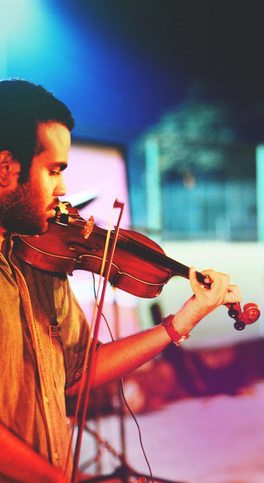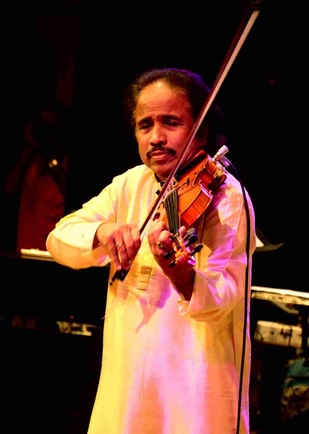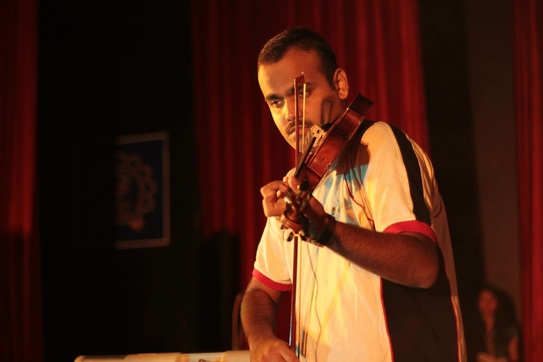|
About This Page
This page is to share blogs/articles written by our members. Members wishing to share their blogs here, please write to us. Archives
August 2018
Categories |
Back to Blog
Inside Indian Music13/8/2015 By Prajwal A N Prajwal A N, a recent graduate from IIT Bombay who has been working in Samsung for a close to year now, is a trained musician. In this post he shares his personal story and gives insights in to what makes music, music.  I started learning Carnatic music when I was 12 years old. I trained for a while as a vocalist before I turned instrumentalist with the violin. What started as a small hobby soon turned into a mainstream activity. For a couple of years, I was training very seriously as a musician until I had to stop most of the extra-curricular activities to concentrate on preparing for the Joint Entrance Examination to the IITs. I did not pursue music seriously in those two years of junior college, but the training I went through by then helped me to still keep in touch with music and improve myself with minimal practice. I did take up music again after I joined IIT Bombay for my undergraduate studies, but could not give it enough time and train with the dedication I had during high school. I did try exploring different other forms of music and learnt to appreciate the differences between them and Carnatic music, which I learnt. Today I would like to share with you the basics of music and hopefully by the end of this post you would get an idea of what music is and how different styles differ. History of Indian music Indian classical music is the music form that originated in the Indian subcontinent. Historically, Indian music originated from the vedas where hymns were sung in musical notes during the yagnas. Historic details of Indian music can be found in the Natya Sastra, an ancient work by Bharata. Indian music had the concept of musical notes, rhythms, and the grammar involving the notes (later evolved into ragas) as early as 200 BC. By the 12th century, there appeared two divergent forms of Indian music, Hindustani and Carnatic classical music. Hindustani music was created by the influence of Persian music on the Indian music of that time and this form is prevalent in the northern part of the Indian subcontinent. Carnatic music developed in the southern part of India, not affected much by these influences. Owing to the common origin in ancient Indian music, both these forms share the concepts of ragas, and talas. But they differ significantly in the way the ragas and talas are structured, and the compositional styles. The compositions in Carnatic music are more lyrical than in Hindustani music. In Hindustani music, the melody is based more on pure notes while in Carnatic music melody is based on ornamentations (gamakas) added to the notes. Listen to this performance to get a feel of how melody differs in both the styles. This song shows how music is inherent to each culture and how it evolves according to the different aspects of that culture. Note that the raga throughout the song is the same (this reinforces the common origin of all the different forms of Indian music), but the way the song is sung is different for different cultures. Music Theory “Music creates order out of chaos: for rhythm imposes unanimity upon the divergent, melody imposes continuity upon the disjointed, and harmony imposes compatibility upon the incongruous.” - Lord Yehudi Menuhin. Melody and rhythm are two cornerstones of music. At the basic level, there are different sounds called notes. In simple terms, ‘Melody’ is the tune obtained by playing different notes/pitches (i.e. frequencies) and ‘Rhythm’ is playing those notes for different durations. Different forms of music use different basis for building melody and rhythm and Indian music uses ragas (for melody) and talas (for rhythm). Swaras (or) Notes: The basic pitched sound in music is called a note (also called swara in Carnatic music). There are 8 swaras (notes) in Indian music are our popular Sa Re Ga Ma Pa Da Ni Sa which increase in frequency in that order. This is similar to the names Do Re Mi Fa So La Ti Do given to the notes in Western music. The frequency which is the sound of the notes, are not absolute. While performing, the frequency of the note Sa is fixed according to the wish of the performer, and this becomes the scale. The frequencies of the other notes are defined based on this scale. In any scale, the frequencies of the notes have the same separation between each other. Ragas: Ragas are defined by restrictions on the 8 swaras that can be used (say 4 out of 8). The order and approach of these chosen swaras gives the melody that we call Ragas. These restrictions help create a unique mood for each raga. The ragas are associated with weather, time of the day and this association comes from the mood of the raga. The ragas get their unique mood and character due to the ornamentations added to the notes in the raga. The ornamentations are generally in form of slides - from one note to another, gentle turn or touch to a note. These ornamentations are not just decorative but also necessary to give the mood of the raga. There are about 1000 ragas organized in a system called the Melakarta system and many more ragas which are not organized. These ragas provide an opportunity to showcase a wide range of moods, and emotions. As an example, the raga Kalyani is associated with auspicious occasions and the raga Harikhamboji is associated with the emotion of Shringara. You can see the difference in the emotions conveyed by these ragas here. Midway through the performance (starting from 7:06), the second violinist shifts the Sa to another note, thus changing the swaras used. Thus even though the absolute frequencies used are the same, due to the change in the scale, and the different ornamentations used the raga changes and so does the feel. Talas: Talas are the basis of rhythm in Indian music. Talas consist of repeating beats in a rhythm and they set the pace of the compositions and improvisations. A cycle in a tala is defined by the number of beats before coming back to the start of the next cycle and gap between these beats. The compositions are set to these cycles. They either start right at the beginning of the cycle, or with a gap after the start of the cycle, and then the whole composition is paced to the cycle. Talas play a very important role in playing percussion instruments in Indian music. Percussion instrumentalist not only accompany vocalists and other instrumentalists in their performances, but also create their own compositions that consist of complex grouping of beats to accentuate the rhythm of the tala. A pretty famous form of rythmic composition is called Mukthaya, which is basically verses (in rhythmic language) repeated thrice in such a way that the cycle of tala is adhered to. Listen to a typical rhythmic composition played by percussionists here. The composition is paced to a simple 8 beat cycle (you can see the artists signal the 8 beat cycle using their hand). Listen to this performance, to appreciate the interplay between melody and rhythm to create music.  My Inspiration - Dr. L Subramaniam. One of the pioneers who changed violin from an accompaniment instrument to a main instrument in Carnatic music. “I find nothing more inspiring than the music making of my very great colleague Subramaniam. Each time I listen to him, I am carried away in wonderment.” - Lord Yehudi Menuhin. Although portions of this post might feel tricky or confusing, on careful reading and relating to music that you hum every day it becomes easy and gives you basic technical knowledge about music. “Music expresses that which cannot be said and on which it is impossible to be silent.” – Victor Hugo This sums up our feelings when we listen to good song, may your souls string with beats of music.
2 Comments
Read More
|
Site developed for IITAAK.

